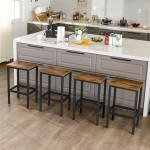Where To Keep Bread In The Kitchen
Bread, a staple in many kitchens, requires careful storage to maintain its freshness and prevent spoilage. From traditional loaves to artisan sourdough, the ideal storage method can significantly impact its texture, flavor, and shelf life. This article explores the best practices for storing bread in the kitchen, considering factors such as bread type, desired shelf life, and available space.
Bread Storage Options
Numerous storage options are available, each offering distinct advantages and disadvantages. Understanding these options allows for informed choices based on individual needs and preferences. The following outlines some common methods:
1. Countertop Storage
Storing bread on the countertop offers easy accessibility but comes with limitations. This method is suitable for freshly baked bread that will be consumed within a day or two. However, exposure to room temperature and humidity can accelerate the staling process, leading to a dry and crumbly texture. To mitigate this, consider using a bread basket or a covered container made of breathable material such as wicker or cloth.
2. Refrigerator Storage
Refrigeration slows down the staling process, extending the shelf life of bread. However, cold temperatures can make bread dry and hard, especially if stored for an extended period. Using a resealable plastic bag or a tightly sealed container is recommended to prevent moisture loss. It's worth noting that refrigeration may not be ideal for all types of bread, particularly those with a high moisture content, as it can lead to a soggy texture.
3. Freezer Storage
Freezing is the most effective method for extending the shelf life of bread. By freezing bread at a low temperature, the staling process is significantly slowed down, preserving its freshness for several months. Before freezing, it is advisable to slice the bread and wrap each slice individually in plastic wrap or aluminum foil. This prevents the bread from sticking together and allows for easy portioning when thawing. When ready to consume, frozen bread can be thawed at room temperature or toasted directly from frozen.
Factors Influencing Bread Storage
The ideal storage method for bread depends on various factors, including the type of bread, its intended shelf life, and personal preferences. Consider these aspects when making storage decisions:
1. Bread Type
Different bread types react differently to storage conditions. For instance, crusty breads like sourdough or baguettes benefit from a quick cool down at room temperature before being stored in a breathable container or bag. This allows the crust to retain its crispness. On the other hand, soft breads like white bread or challah are best stored in the refrigerator or freezer to prolong their shelf life and prevent mold growth.
2. Desired Shelf Life
The intended shelf life of the bread plays a crucial role in storage decisions. If the bread is expected to be consumed within a day or two, countertop storage may suffice. However, for longer shelf life, refrigeration or freezing is recommended.
3. Available Space
Kitchen space constraints can influence storage options. Countertop storage is ideal for smaller kitchens with limited space. Refrigerators and freezers offer ample storage space, but they require proper organization and planning to avoid overcrowding and inefficiencies.
Tips for Optimal Bread Storage
To maximize the freshness and longevity of bread, consider the following tips:
*Avoid Storing Bread Near Heat Sources:
Heat can accelerate the staling process, so keep bread away from ovens, stoves, and other heat sources. *Use Breathable Containers:
Opt for containers made of breathable materials such as wicker, cloth, or paper bags to allow air circulation and prevent moisture buildup. *Wrap Bread Properly:
When storing bread in the refrigerator or freezer, wrap it tightly in plastic wrap or aluminum foil to prevent moisture loss and freezer burn. *Label and Date Bread:
Labeling frozen bread with the date of freezing helps maintain organization and ensures that older bread is consumed first.By implementing these storage practices, bread can be enjoyed fresh and flavorful for extended periods. These tips cater to diverse bread types and shelf-life requirements, ensuring optimal preservation and enjoyment of this culinary staple.

Bakers Home Storage Tips For Sliced Bread S 90th Birthday

How To Store Fresh Baked Bread

Bread Storage Solution How I Store My Small Kitchen Organization Noreen S Youtube

Where To Store Bread In The Kitchen

Kitchen Organization Tip Storing Produce And Bread In Rolling Cart

Best Way To Store Bread 4 Methods Tested

Food Expert Warns Against Popular Bread Storage Method During Hot Weather Express Co

Bamboo Bread Box Keep The Fresh For Kitchen Counter Large Capacity Wooden Storage Container Farmhouse With Window Holder

16 Best Diy Dresser Makeovers Ideas For Old Or Unused Furniture

Bamboo Bread Box Keep The Fresh For Kitchen Counter Large Capacity Wooden Storage Container Farmhouse With Window Holder








